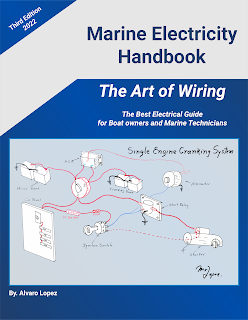Marine Lightning Protection
Lightning Protection
The combination of vertically moving water droplets and air currents results in the buildup of large quantities of oppositely charged particles within clouds and between clouds and the ground.
The electrical potential differences between charges may be as high as 100’000.000 Volts.
By comparison, the voltage on the power lines running along a street is 12.000 Volts.
The base of a cloud becomes negatively charged. Since opposite charges attract, the surface of the earth directly beneath the cloud becomes positively charged.
The base of a cloud becomes negatively charged. Since opposite charges attract, the surface of the earth directly beneath the cloud becomes positively charged.
It is very difficult to study lightning for many reasons. It occurs very randomly even within ideal conditions and varies greatly in its attributes; a bit akin to snowflakes, no two lightning bolts are alike.
Get here the Marine Electricity Handbook where you can find all the information on this and many other topics.
Lightning Protection for Powerboats
For powerboats, I recommend having a short mast with a lightning rod attached. If the mast is metal use 4awg wire at the base of the mast to connect through to our grounding source.
If you don't have a metal mast you will need to run 4awg wire all the way from the lightning rod to the grounding source. Your engines should also have a 4awg wire going bonding wire going directly to the grounding plate for bonding as well as extra protection against stray lightning current/voltage.
For sailboats with aluminum masts attaching a 1/4'' stainless steel rod-shaped to a point with a good connection to the mast will do. The mast will conduct the lightning down.
Learn more in the following video
For sailboats with aluminum masts
The top of the lightning rod should be 6'' above anything else on the mast and filed to a sharp point. At the base of the mast, we have to connect directly as possible to a good ground ie an external keel through a keel bolt or attaching to a metal centerboard.
The top of the lightning rod should be 6'' above anything else on the mast and be filed to a sharp point. At the base of the mast, we have to connect directly as possible to a good ground ie an external keel through a keel bolt or attaching it to a metal centerboard.
It should be made of corrosion-resistant materials such as ( copper, bronze or monel) and no less than 1 ft square.








Comments
Post a Comment